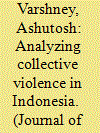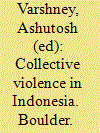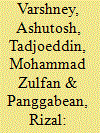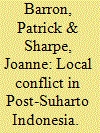|
|
|
Sort Order |
|
|
|
Items / Page
|
|
|
|
|
|
|
| Srl | Item |
| 1 |
ID:
084034


|
|
|
| 2 |
ID:
098817


|
|
|
|
|
| Publication |
Boulder, Lynne Rienner Publishers, 2010.
|
| Description |
x, 193p.
|
| Standard Number |
9781588266873, hbk
|
|
|
|
|
|
|
|
|
|
|
|
Copies: C:1/I:0,R:0,Q:0
Circulation
| Accession# | Call# | Current Location | Status | Policy | Location |
| 055221 | 303.609598/VAR 055221 | Main | On Shelf | General | |
|
|
|
|
| 3 |
ID:
084035


|
|
|
|
|
| Publication |
2008.
|
| Summary/Abstract |
Indonesia has witnessed explosive group violence in recent years, but unlike its plentiful economic statistics, the data on conflict are remarkably sketchy. Because the New Order (1966-1998) wanted to give the appearance of order and stability, it did not believe in publishing reports on group conflict, nor did it allow researchers and nongovernmental organizations to probe the patterns and causes of conflict. This article is based on the first multiyear dataset ever constructed on group violence in Indonesia. Following, and adapting for Indonesian conditions, methodologies developed and used elsewhere, we cover the years 1990-2003, split the data into various categories, and identify the national, regional, and local patterns of collective violence. Much that we find is surprising, given the existing theories and common perceptions about violence in Indonesia. Of the several conclusions we draw, the most important one is that group violence in Indonesia is highly locally concentrated. Fifteen districts and cities (kabupaten and kota), in which a mere 6.5 percent of the country's population lived in 2000, account for as much as 85.5 percent of all deaths in group violence. Large-scale group violence is not as widespread as is normally believed. If we can figure out why so many districts remained reasonably quiet, even as the violent systemic shifts-such as the decline of the New Order-deeply shook fifteen districts causing a large number of deaths, it will advance our understanding of the causes of collective violence in Indonesia.
|
|
|
|
|
|
|
|
|
|
|
|
|
|
|
|
| 4 |
ID:
084037


|
|
|
|
|
| Publication |
2008.
|
| Summary/Abstract |
Responding to conflict, in Indonesia and elsewhere, requires an understanding of its distribution, forms, and impacts. In this article, we outline an attempt to use local newspaper monitoring to measure the levels and impacts of violent conflict during the period 2001-2003 in two Indonesian provinces (East Java and NTT). We also assess variation in incidence, impact, and form across and within areas. The study data suggest first that previous research has vastly underestimated the impacts of violent conflict in Indonesia. Comparing our data with those of the previous attempt to use newspapers to map conflict in Indonesia (by the UN Support Facility for Indonesian Recovery [UNSFIR]), we find three times as many deaths from collective violence. These differences are a function of the level of news sources used, with provincial papers picking up only a small proportion of deaths in our research areas. Further, we argue that the impacts of certain types of violence between individuals should be included, leading to even higher figures. Second, our data call into question the dictum that violence in Indonesia is concentrated in a small number of regions. While there is variation between districts, we record large impacts from collective violence in areas not previously considered conflict-prone. Third, substantial variations in conflict form are found across regions, and these result in different kinds of impacts. This underlines the importance of consideration of the role of local factors in driving conflicts and suggests that approaches must be tailored to local conditions. Finally, we demonstrate that using local newspapers to measure and analyze conflicts presents a useful tool for understanding conflict in Indonesia. The use of subprovincial news sources captures more accurate estimates of conflict incidence than other methods, such as provincial newspaper mapping or surveying. It can also provide a basis for a deeper understanding of variations in patterns of conflict across areas and provide insights into how we might respond.
|
|
|
|
|
|
|
|
|
|
|
|
|
|
|
|
|
|
|
|
|